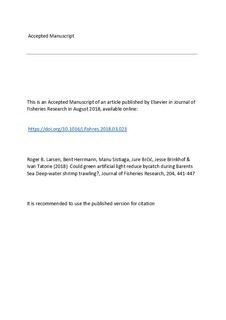| dc.contributor.author | Larsen, Roger B. | |
| dc.contributor.author | Herrmann, Bent | |
| dc.contributor.author | Sistiaga, Manu Berrondo | |
| dc.contributor.author | Brcic, Jure | |
| dc.contributor.author | Brinkhof, Jesse | |
| dc.contributor.author | Tatone, Ivan | |
| dc.date.accessioned | 2019-04-16T09:32:53Z | |
| dc.date.available | 2019-04-16T09:32:53Z | |
| dc.date.created | 2018-04-03T10:31:12Z | |
| dc.date.issued | 2018-08 | |
| dc.identifier.citation | Fisheries Research. 2018, 204 441-447. | nb_NO |
| dc.identifier.issn | 0165-7836 | |
| dc.identifier.uri | http://hdl.handle.net/11250/2594789 | |
| dc.description.abstract | The Nordmøre grid is widely used in shrimp trawls to reduce the bycatch of fish species. However, small-sized fish species and juveniles still pass through the grid and enter the codend, along with the targeted shrimp. This bycatch of small fish has a negative impact on the ecosystem due to increased fish mortality, and leads to additional sorting work onboard. Some small-sized fish that enter the trawl avoid entering the codend by escaping through the outlet above the grid, without making contact with the grid itself. Design changes that promote this behavior could potentially reduce bycatch in shrimp trawl fisheries. Light-emitting diodes (LEDs) mounted around the escape outlet have previously been found to have either a negative effect, or no effect at all, on fish bycatch species. This study investigates the effect of mounting green LEDs on the lower part of a Nordmøre grid, to determine if their presence would encourage bycatch fish to rise towards the escape outlet prior to contacting the grid. Experimental fishing trials were conducted to assess the size selective properties of a 19 mm bar spaced Nordmøre grid with and without LEDs, mounted on a bottom trawl targeting Deep-water shrimp (Pandalus borealis). For the four bycatch species investigated, 51–100% of small fish passed through the Nordmøre grid. The addition of green LEDs to the Nordmøre grid did not significantly affect the escape probability or the size selectivity of any of the investigated species. Very few Deep-water shrimp were found to escape through the escape outlet independent of the presence of the LEDs mounted on the grid | nb_NO |
| dc.language.iso | eng | nb_NO |
| dc.rights | Attribution-NonCommercial-NoDerivatives 4.0 Internasjonal | * |
| dc.rights.uri | http://creativecommons.org/licenses/by-nc-nd/4.0/deed.no | * |
| dc.subject | Bottom trawl | nb_NO |
| dc.subject | Bycatch | nb_NO |
| dc.subject | LEDs | nb_NO |
| dc.subject | Nordmøre grid | nb_NO |
| dc.subject | Pandalus borealis | nb_NO |
| dc.subject | Size selectivity | nb_NO |
| dc.title | Could green artificial light reduce bycatch during Barents Sea Deep-water shrimp trawling? | nb_NO |
| dc.type | Journal article | nb_NO |
| dc.type | Peer reviewed | nb_NO |
| dc.description.version | acceptedVersion | nb_NO |
| dc.subject.nsi | VDP::Fangst: 925 | nb_NO |
| dc.subject.nsi | VDP::Catch: 925 | nb_NO |
| dc.source.pagenumber | 441-447 | nb_NO |
| dc.source.volume | 204 | nb_NO |
| dc.source.journal | Fisheries Research | nb_NO |
| dc.identifier.doi | 10.1016/j.fishres.2018.03.023 | |
| dc.identifier.cristin | 1576691 | |
| dc.relation.project | Fiskeri- og havbruksnæringens forskningsfond: 901303 | nb_NO |
| cristin.unitcode | 7566,2,0,0 | |
| cristin.unitname | Sjømatteknologi | |
| cristin.ispublished | true | |
| cristin.fulltext | postprint | |
| cristin.qualitycode | 1 | |

